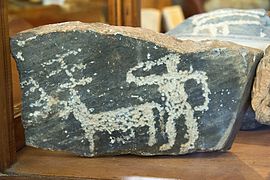Corfi t 'Aroniou
Coordinates: 36 ° 58 ′ 39.7 ″ N , 25 ° 33 ′ 14 ″ E
Korfi t 'Aroniou ( Greek Κορφή τ' Αρωνιού also Korphi t 'Aroniou ) is the site of a fortified, Early Bronze Age settlement in the southeast of the Cycladic island of Naxos .
Location
The site is on the free-standing mountain Korfi t 'Aroniou less than a kilometer southwest of the coastal settlement of Klido in the southeast of Naxos and about 350 meters from the coast. The summit area of the conical, steeply rising mountain is terraced and surrounded by several walls. The terraces were used for agriculture in modern times. At the top there is a mitato , a mortarless building made of natural stone.
The excavations were carried out in the early 1960s under the direction of Christos Doumas . Doumas published the finds in 1965. They are exhibited on the island in the Archaeological Museums of Naxos and Apiranthos .
Finds
The structural remains are distributed over the terraces of the summit area. The best preserved in the lower area is an oval building, 2.8 mx 2.1 m and an assumed height of 1.3 m. The building was built in a cantilever construction from flat stones with a mortar connection. The wall thickness was 30 to 60 cm. The entrance was on the east side. The sparse finds of utility ceramics in the interior date from FK II to FK IIIA of the Cycladic culture . Together with two small obsidian blades and two large millstones, they indicate domestic activities.
The most important finds are ten marble stone slabs with figurative representations. These stone slabs were built into the modern dry stone wall like normal bricks . The motifs are schematically picked into the approximately 30 x 50 cm large panels. They show scenes from everyday life such as hunting, cattle breeding, seafaring and a dance or fight scene. In the representations, the choice of scenes and the artistic execution there is a correspondence with the rock carvings of Strofilas on the Cycladic island of Andros , which makes their dating in the existing FK II situation probable. Numerous beach pebbles near the entrance to the settlement probably served the residents as slingshot bullets.
Korfi t 'Aroniou is one of numerous known sites of very small size, it covered a maximum of 800 m². The settlement offered space for up to two households with a total of ten residents.
meaning
Besides Corfi t 'Aroniou , only Strofilas is known to be the place where comparable petroglyphs were found in the Cyclades . The often held view that the scenes on the marble slabs in connection with the oval building indicate a cultic meaning of Korfi t 'Aroniou is discussed.
literature
- Lila Marangou (Ed.): Cycladic Culture-Naxos in the 3rd Millenium BC. Nicholas P. Goulandris Foundation - Museum of Cycladic Art, Athens 1990, ISBN 960-7064-02-X , p. 179 .
Individual evidence
- ↑ Christos Doumas : Κορφή τ ' Αρωνιού. Μικρά ανασκαφική έρευνα εν Νάξω . In: Η εν Αθήναις Αρχαιολογική Εταιρεία, Athens Archaeological Society (ed.): Αρχαιολογικό Δελτίο . 1965, p. 41-64 .
- ↑ Vaia Economidou: Cycladic Settlements in the Early Bronze Age Aegean and Their Context . 1993, p. 107-109 (Ph.D. Dissertation, University College London ).
- ^ Sinclair Hood: The Arts in Prehistoric Greece . Yale University Press, 1994, ISBN 978-0-300-05287-9 , pp. 94 f .
- ↑ Stefanie Hubert: Hillside location and sea view - On early Cycladic house and settlement architecture . In: Badisches Landesmuseum (Ed.): Cyclades - Living Worlds of an Early Greek Culture (exhibition catalog) . Primus, 2011, ISBN 978-3-534-24894-0 , pp. 73 . ; Joseph Maran : Cultural change on mainland Greece and the Cyclades in the late 3rd millennium BC Studies on the cultural conditions in Southeast Europe and the central and eastern Mediterranean area in the late Copper and early Bronze Ages . Habelt, Bonn 1998, ISBN 3-7749-2870-3 , p. 294 (habilitation thesis).
- ↑ Eva Alram-Stern, Nicholas Efstratiou (ed.): The Aegean Early Time. 2nd series. Research report 1975–1993 . Publishing house of the Austrian Academy of Sciences, Vienna 1996, ISBN 978-3-7001-2280-7 , p. 392 .
- ↑ Cyprian Broodbank: At Iceland Archeology of the Early Cyclades . Cambridge University Press, 2002, ISBN 978-0-521-52844-3 , pp. 177 .
- ↑ Mariya Ivanova: Fortified settlements in the Balkans, in the Aegean Sea and in Western Anatolia, approx. 5000–2000 BC. Chr. Waxmann Verlag, 2008, ISBN 978-3-8309-1937-7 , pp. 189 .
- ↑ Maran 1998; 293 f




